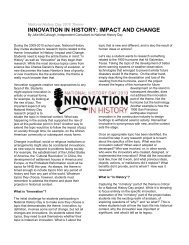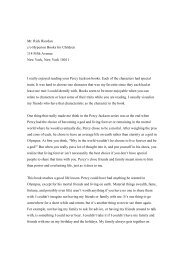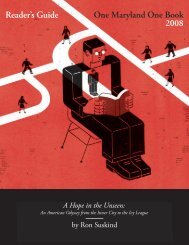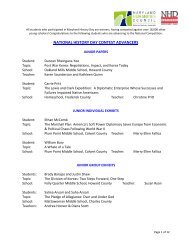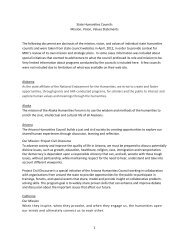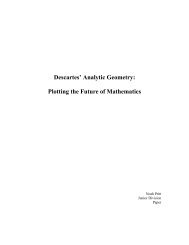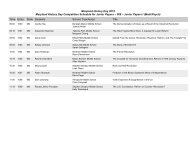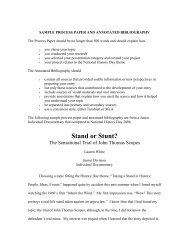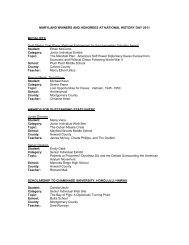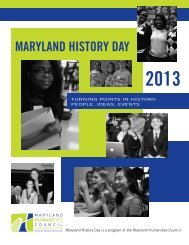A Hope in the Unseen: by Ron Suskind - Maryland Humanities Council
A Hope in the Unseen: by Ron Suskind - Maryland Humanities Council
A Hope in the Unseen: by Ron Suskind - Maryland Humanities Council
Create successful ePaper yourself
Turn your PDF publications into a flip-book with our unique Google optimized e-Paper software.
ASSIGNMENT #5Pages 208-261 (end of chapter 10)Vocabulary: ethos (pg. 220)anachronistic (pg. 223)addendum (pg. 243)piqued (pg. 246)patrician (pg. 248)languid (pg. 255)assimilationist (pg. 258)juxtaposition (pg. 260)Discussion Questions:1. Why do you th<strong>in</strong>k Susk<strong>in</strong>d <strong>in</strong>cludes so much<strong>in</strong>formation about Cedric’s fa<strong>the</strong>r even though he has solittle contact with his son?2. Was Barbara wise or foolish to make <strong>the</strong> trip to Brownfor parents’ weekend? (pg. 227)3. Why is Cedric so surprised that Zayd didn’t grow up tohate black people? (pg. 246)4. Who made <strong>the</strong> strongest impact on Cedric when he wasat Mr. Korb’s house for Thanksgiv<strong>in</strong>g? Why? (pg. 249)5. What does Professor James mean when he says Cedricis “not accommodationist” and is “culturally fixed?”Would you agree or disagree? Are <strong>the</strong>se descriptionsnegative or positive? (pg. 260)ASSIGNMENT #6Pages 262-303 (end of chapter 12)Vocabulary: candor (pg. 263)cont<strong>in</strong>gency (pg. 266)jocular (pg. 272)cursory, acerbic (pg. 282)Discussion Questions:1. Read Cedric’s mus<strong>in</strong>gs on pages 274 and 275. What is<strong>the</strong> difference between pride and confidence? Whichdoes Cedric possess?2. What contradiction has been a “real shock” to Cedric?(pg. 275)3. Why is it harder for Cedric to be friends with Zaydthan it is for Zayd to be friends with Cedric? (pgs. 277-280)4. Susk<strong>in</strong>d describes <strong>the</strong> groups at Brown. (pgs. 292-293)How are such divisions positive? How are <strong>the</strong>y negative?5. What evidence does Susk<strong>in</strong>d provide that Cedric ischang<strong>in</strong>g?6. What does Wakeford mean when he tells Cedric, “Thekey […] is to put your outrage <strong>in</strong> a place where you canget at it when you need to, but not have it bubble up somuch, especially when you’re asked to embrace new ideasor expla<strong>in</strong> what you observe to people who share none ofyour experiences?” (pg. 303)ASSIGNMENT #7Pages 304-361 (end of chapter 14)Vocabulary: imprimatur (pg. 307)proprietary (pg. 315)admonitions (pg. 332)entropic (pg. 334)beef<strong>in</strong>’ (pg. 353)extricate (pg. 359)Discussion Questions:1. What does Cedric’s l<strong>in</strong>e of poetry, “Let <strong>the</strong> colorsrun…” mean to you? Do you like it as much as Zaydand Cedric? (pg. 305)2. Ch<strong>in</strong>iqua says, <strong>in</strong> reference to music and culture, “Youhave to have grown up with it like us, to really know it.”(pg. 315) Do you agree or disagree? If this is true, whatdoes it tell us about cross-cultural relationships? Doesmulticultural education <strong>the</strong>n not have a purpose?3. What are some of <strong>the</strong> elements of Cedric’s personalitythat helped him make it through his first year at Brown?4. Why do you th<strong>in</strong>k Cedric and Rob had so manydifficulties as roommates?5. How is Barbara’s pride different from Cedric’s pride?6. Do you th<strong>in</strong>k that Cedric has become a man <strong>by</strong> <strong>the</strong> endof <strong>the</strong> story? Why or why not? Use situations from <strong>the</strong>story to justify your op<strong>in</strong>ion.ASSIGNMENT #8Pages 362-end (epilogue, author’s note, afterword)No vocabularyNo specific discussion questionsJust readAfter Read<strong>in</strong>g• Take time to return to <strong>the</strong> class questions createddur<strong>in</strong>g <strong>the</strong> Before Read<strong>in</strong>g PowerPo<strong>in</strong>t (found at www.onemarylandonebook.org under Teacher Resources).• Allow students small group time to discern whe<strong>the</strong>r <strong>the</strong>story, epilogue, author’s note, and afterword were ableto answer all <strong>the</strong> questions <strong>in</strong>itially posed.• Erase all questions that were answered and see if any of<strong>the</strong> Extension projects supply <strong>the</strong> answers.6



